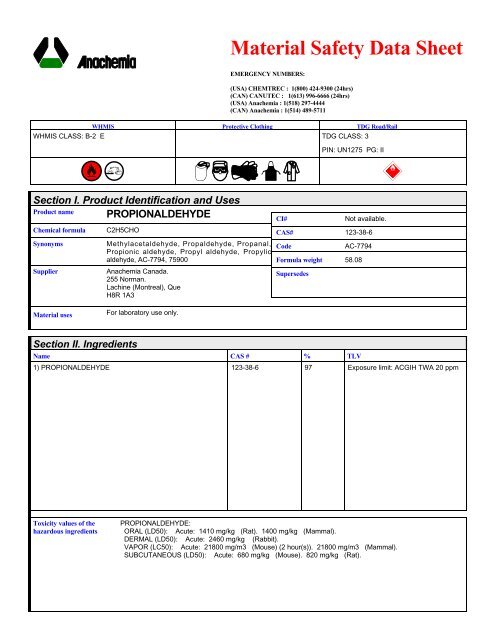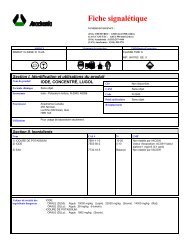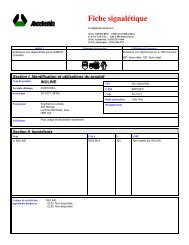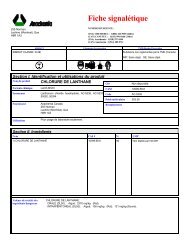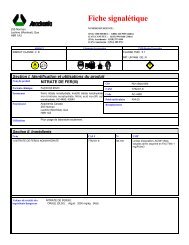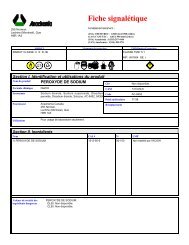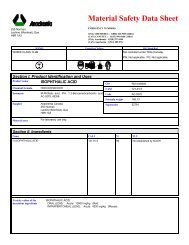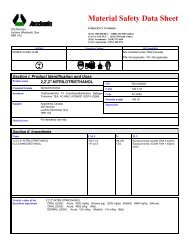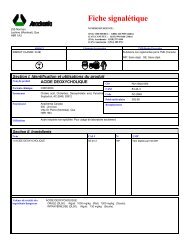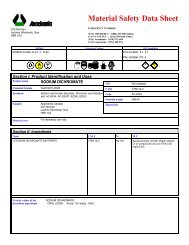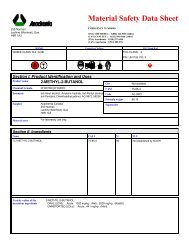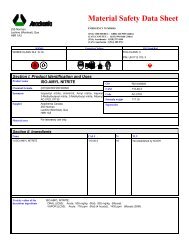8145 PROPIONALDEHYDE (English) ANACHEMIA MSDS Canada ...
8145 PROPIONALDEHYDE (English) ANACHEMIA MSDS Canada ...
8145 PROPIONALDEHYDE (English) ANACHEMIA MSDS Canada ...
Create successful ePaper yourself
Turn your PDF publications into a flip-book with our unique Google optimized e-Paper software.
Section I. Product Identification and Uses<br />
Product name <strong>PROPIONALDEHYDE</strong><br />
C2H5CHO<br />
Section II. Ingredients<br />
Methylacetaldehyde, Propaldehyde, Propanal,<br />
Propionic aldehyde, Propyl aldehyde, Propylic<br />
aldehyde, AC-7794, 75900<br />
Anachemia <strong>Canada</strong>.<br />
255 Norman.<br />
Lachine (Montreal), Que<br />
H8R 1A3<br />
For laboratory use only.<br />
Material Safety Data Sheet<br />
WHMIS Protective Clothing TDG Road/Rail<br />
WHMIS CLASS: B-2 E TDG CLASS: 3<br />
Chemical formula<br />
Synonyms<br />
Supplier<br />
Material uses<br />
CI#<br />
CAS# 123-38-6<br />
Code AC-7794<br />
Formula weight<br />
Supersedes<br />
PIN: UN1275 PG: II<br />
Not available.<br />
1) <strong>PROPIONALDEHYDE</strong> 123-38-6 97 Exposure limit: ACGIH TWA 20 ppm<br />
Toxicity values of the<br />
hazardous ingredients<br />
EMERGENCY NUMBERS:<br />
(USA) CHEMTREC : 1(800) 424-9300 (24hrs)<br />
(CAN) CANUTEC : 1(613) 996-6666 (24hrs)<br />
(USA) Anachemia : 1(518) 297-4444<br />
(CAN) Anachemia : 1(514) 489-5711<br />
Name CAS # %<br />
58.08<br />
TLV<br />
<strong>PROPIONALDEHYDE</strong>:<br />
ORAL (LD50): Acute: 1410 mg/kg (Rat). 1400 mg/kg (Mammal).<br />
DERMAL (LD50): Acute: 2460 mg/kg (Rabbit).<br />
VAPOR (LC50): Acute: 21800 mg/m3 (Mouse) (2 hour(s)). 21800 mg/m3 (Mammal).<br />
SUBCUTANEOUS (LD50): Acute: 680 mg/kg (Mouse). 820 mg/kg (Rat).<br />
3
Section III. Physical Data<br />
Physical state and<br />
appearance / Odor<br />
pH (1% soln/water)<br />
Odor threshold<br />
Percent volatile<br />
Freezing point<br />
Boiling point<br />
Specific gravity<br />
Vapor density<br />
Vapor pressure<br />
Water/oil dist. coeff.<br />
Evaporation rate<br />
Solubility<br />
Colorless liquid. Suffocating odor.<br />
Not available.<br />
Not available.<br />
100% (V/V)<br />
-81°C<br />
46 to 50°C<br />
0.805 (Water = 1)<br />
2 (Air = 1)<br />
258 mm of Hg @ 20°C<br />
Not available.<br />
Not available.<br />
Miscible in water.<br />
Section IV. Fire and Explosion Data<br />
Flash point<br />
Flammable limits<br />
Auto-ignition temperature 206°C<br />
Fire degradation<br />
products<br />
Fire extinguishing<br />
procedures<br />
Fire and Explosion<br />
Hazards<br />
CLOSED CUP: -30°C<br />
LOWER: 2.3% UPPER: 21%<br />
Section V. Toxicological Properties<br />
<strong>PROPIONALDEHYDE</strong> page 2/4<br />
Use DRY chemical, carbon dioxide, or alcohol-resistant foam. Water may be ineffective to extinguish fires. Wear<br />
adequate personal protection to prevent contact with material or its combustion products. Self contained breathing<br />
apparatus with a full facepiece operated in a pressure demand or other positive pressure mode. Cool containing vessels<br />
with flooding quantities of water. Fight fire from maximum distance or use unmanned hose holders or monitor nozzles.<br />
Extremely flammable. Vapor may travel considerable distance to source of ignition and flash back, eliminate all<br />
sources of ignition. Vapor forms explosive mixture with air. Container explosion may occur under fire conditions or<br />
when heated. Contact with oxidizers may cause fire and/or explosion. Empty container may contain explosive or<br />
flammable residue. Sensitive to static discharge. Forms explosive peroxides on prolonged storage. Emits toxic<br />
fumes under fire conditions.<br />
Routes of entry Ingestion and inhalation. Eye contact. Skin contact. Skin absorption.<br />
Effects of Acute<br />
Exposure<br />
Skin<br />
Inhalation<br />
Ingestion<br />
Oxides of carbon (CO, CO2).<br />
Harmful by inhalation, in contact with skin and if swallowed. Corrosive. Target organs: eyes, skin, respiratory<br />
system.<br />
Eye Causes severe burns and loss of vision. May cause permanent damage. IRRITATION: EYE-RABBIT 41 mg<br />
SEVERE<br />
Causes severe burns.<br />
Material is extremely destructive to tissue of the mucous membranes and upper respiratory tract. Inhalation may be<br />
fatal as a result of spasm, inflammation and edema of the larynx and bronchi, chemical pneumonitis and pulmonary<br />
edema. Symptoms of exposure may include burning sensation, coughing, laryngitis, dyspnea, headache, nausea, and<br />
vomiting. High concentrations may cause narcosis and loss of consciousness.<br />
Burns in mouth, pharynx and gastrointestinal tract. See inhalation.
Section V. Toxicological Properties<br />
Effects of Chronic<br />
Overexposure<br />
Section VI. First Aid Measures<br />
Eye contact<br />
Skin contact<br />
Inhalation<br />
Ingestion<br />
Stability<br />
Hazardous decomp.<br />
products<br />
Incompatibility<br />
If conscious, wash out mouth with water. Never give anything by mouth to an unconscious or convulsing person.<br />
Seek immediate medical attention.<br />
Section VII. Reactivity Data<br />
Reaction Products<br />
Unstable. Air sensitive. Forms explosive peroxides on contact with air. Conditions to avoid: High temperatures,<br />
sparks, open flames and all other sources of ignition, contamination.<br />
Not available.<br />
<strong>PROPIONALDEHYDE</strong> page 3/4<br />
Carcinogenic effects: Not available. Mutagenic effects: Not available. Teratogenic effects: Not available. Toxicity of the<br />
product to the reproductive system: Not available. To the best of our knowledge, the chemical, physical, and toxicity of<br />
this substance has not been fully investigated.<br />
Immediately flush eyes with copious quantities of water for at least 15 minutes holding lids apart to ensure flushing of<br />
the entire surface. Call a physician.<br />
Immediately flush skin with plenty of water for at least 15 minutes while removing contaminated clothing and shoes.<br />
Call a physician. Wash contaminated clothing before reusing.<br />
Remove patient to fresh air. Administer approved oxygen supply if breathing is difficult. Administer artificial respiration<br />
or CPR if breathing has ceased. Seek immediate medical attention.<br />
Oxidizing materials, acids, bases, reducing materials, amines, organic acids, halogens, alcohols. Polymerizes<br />
violently in presence of methyl methacrylate.<br />
Forms explosive peroxides on prolonged storage. If they become concentrated, these peroxides may present an<br />
explosion hazard.
Section VIII. Preventive Measures<br />
Protective Clothing in<br />
case of spill and leak<br />
Spill and leak<br />
Waste disposal<br />
Storage and Handling<br />
Wear self-contained breathing apparatus, rubber boots and heavy rubber gloves.<br />
Evacuate the area. Eliminate all sources of ignition and ensure that all handling equipment is electrically grounded.<br />
Stay upwind: Keep out of low areas. Cover with an activated carbon adsorbent. Place in a suitable container and<br />
mark for disposal. Use non-sparking tools. Transport outdoors. Ventilate area and wash spill site after material pick<br />
up is complete. DO NOT empty into drains. DO NOT touch damaged container or spilled material. Runoff to sewer<br />
may create fire or explosion hazard.<br />
Burn in a chemical incinerator equipped with an after burner and scrubber. According to all applicable regulations.<br />
Harmful to aquatic life at low concentrations. Can be dangerous if allowed to enter drinking water intakes. Do not<br />
contaminate domestic or irrigation water supplies, lakes, streams, ponds, or rivers.<br />
May develop pressure. Refrigerate. Store in a cool place away from heated areas, sparks, and flame. Store in a well ventilated area.<br />
Store away from incompatible materials. Do not add any other material to the container. Do not wash down the drain. Do not breathe<br />
gas/fumes/vapor/spray. In case of insufficient ventilation, wear suitable respiratory equipment. Keep away from direct sunlight or strong<br />
incandescent light. Keep container tightly closed and dry. Store under nitrogen. Manipulate under an adequate fume hood. Take<br />
precautionary measures against electrostatic discharges. Ground the container while dispensing. Ground all equipment containing<br />
material. Use explosion proof equipment. Use non-sparking tools. Watch for accumulation in low confined areas. Empty containers may<br />
contain a hazardous residue. Do not use pressure to dispense. Handle and open container with care. Take off immediately all<br />
contaminated clothing. This product must be manipulated by qualified personnel. Do not get in eyes, on skin, or on clothing. Wash well<br />
after use. In accordance with good storage and handling practices. Do not allow smoking and food consumption while handling. Never<br />
use welding or cutting torch on or near drum (even empty) because product (even just residue) can ignite explosively.<br />
Section IX. Protective Measures<br />
Protective clothing<br />
Section X. Other Information<br />
<strong>PROPIONALDEHYDE</strong><br />
page 4/4<br />
Face shield and splash goggles. Impervious gloves, apron, coveralls, and/or other resistant protective clothing. Sufficient to protect skin. If use conditions generate<br />
vapors or mists, wear a NIOSH-approved respirator appropriate for those emission levels. Appropriate respirators may be a full facepiece or a half mask air-purifying<br />
cartridge respirator equipped for organic vapors/mists, a self-contained breathing apparatus in the pressure demand mode, or a supplied-air respirator. Do not wear<br />
contact lenses. Make eye bath and emergency shower available. Ensure that eyewash station and safety shower is proximal to the work-station location.<br />
Engineering controls Use in a chemical fume hood. Use explosion-proof ventilation equipment. Use adequate ventilation. Do not use in<br />
unventilated spaces.<br />
Special Precautions or<br />
comments<br />
Extremely flammable liquid! Corrosive! Stench. Do not breathe vapor. Avoid all contact<br />
with the product. Avoid prolonged or repeated exposure. Use in a chemical fume hood.<br />
Keep away from heat, sparks and flame. Use non-sparking tools. Take precautionary<br />
measures against static discharges. Bond and ground transfer containers and equipment to<br />
avoid static accumulation. Air sensitive. Forms explosive peroxides on prolonged storage.<br />
Store under nitrogen. May develop pressure. Refrigerate. Open carefully. Do not allow to<br />
evaporate to near dryness. CAUTION: This product tends to form peroxides which are<br />
relatively unstable and decompose violently. Therefore, any peroxide forming material<br />
should be tested to the presence of peroxides before use. No propionaldehyde should be<br />
distilled to dryness or concentrated unless peroxides have been proven to be absent.<br />
Handle and open container with care. Container should be opened only by a technically<br />
qualified person.<br />
Synergistic materials: Not available.<br />
RTECS NO: UE0350000 (Propionaldehyde).<br />
Prepared by <strong>MSDS</strong> Department/Département de F.S.. Validated 28-Nov-2012<br />
Telephone# (514) 489-5711<br />
2 3 2<br />
NFPA<br />
While the company believes the data set forth herein are accurate as of the date hereof, the company makes no warranty with respect thereto<br />
and expressly disclaims all liability for reliance thereon. Such data are offered solely for your consideration, investigation and verification.


